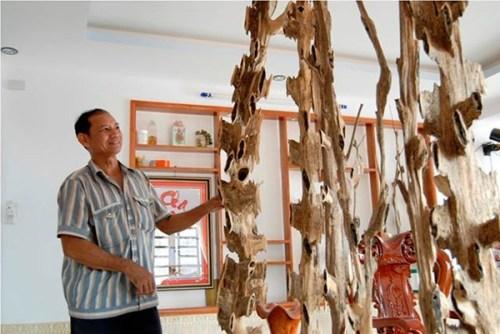

Aloeswood (Aquilaria malaccensis), or tram huong as called by the Vietnamese, is a species of plant favored by Vietnamese and Asian countries because of its special fragrance. Tram huong is the major source of agarwood, a resinous heartwood, used for perfume and incense.
Local newspapers have quoted Tran Duy Linh, a herbalist, as saying that tram huong can be used to cure some diseases, especially digestive problems, and help improve virility. It is very expensive, with one kilo priced at hundreds of millions of dong.
Khoan said that he had spent 17 years looking for tram huong in the wild, but had failed, because the plants had become more scarce due to unfavorable habitat conditions.
So he decided to create tram huong himself, though other people believed that tram huong could only be found in “nature”.
At first, Khoan planted young gio bau (Aquilaria Agallocha in his garden. When the trees grew to a diameter of 10-15 cm, he injected chemicals into the trunks, hoping to create artificial aloeswood. However, the method was not successful.
He decided to stimulate the fragrance-creation process by injecting a mixture of molasses, maize bran and coconut-oil extract. However, though the biological product was safe and helpful to the tram huong creation, it still was unsatisfactory.
Then one day, Khoan found a tree trunk with some holes with ants’ nests inside. It was a surprise to him that the veins around the ants’ nests looked shiny-black, similar to the color of tram huong in the wild.
Khoan decided to breed ants to create tram huong.
“Ants produce a substance which helps the process of forming tram huong on Aquilaria Agallocha (gio bau) more quickly than any artificial method,” Khoan said about the role of the ants.
“Ants eat plants and produce the liquid which has a color like molasses. The liquid, if mixed with molasses, bee honey, maize bran and coconut oil extract, will help speed up the fermentation process which allows it to create biological products.”
When the biological product is injected into the “wounds” on bau gio plants, the plants will have to produce a kind of “antibiotic” to cover the wounds to fight bacteria. This is an important condition to create tram huong.
“My biological product can create third- and fourth-class tram huong, while chemicals can make fifth- or sixth-class products which have lower quality,” he said.
The biological product also helps shorten the time to create tram huong, from 12-18 months to six to nine months.
The scientific discovery has been utilized by Khoan on a production area of five hectares. With over 3,000 bau gio plants in the area, Khoan expects to earn tens of billions of dong.






- Hanoi honors outstanding faces in innovation, digital transformation
- Land deed digitization accelerated in Hanoi
- Vietnam's capital boosts iHanoi usage by citizens
- Technology, innovation identified as key drivers for Hanoi's growth
- Hanoi intensifies efforts to achieve its digital goals by 2025
- Second Hanoi Technical Innovation Contest launched
